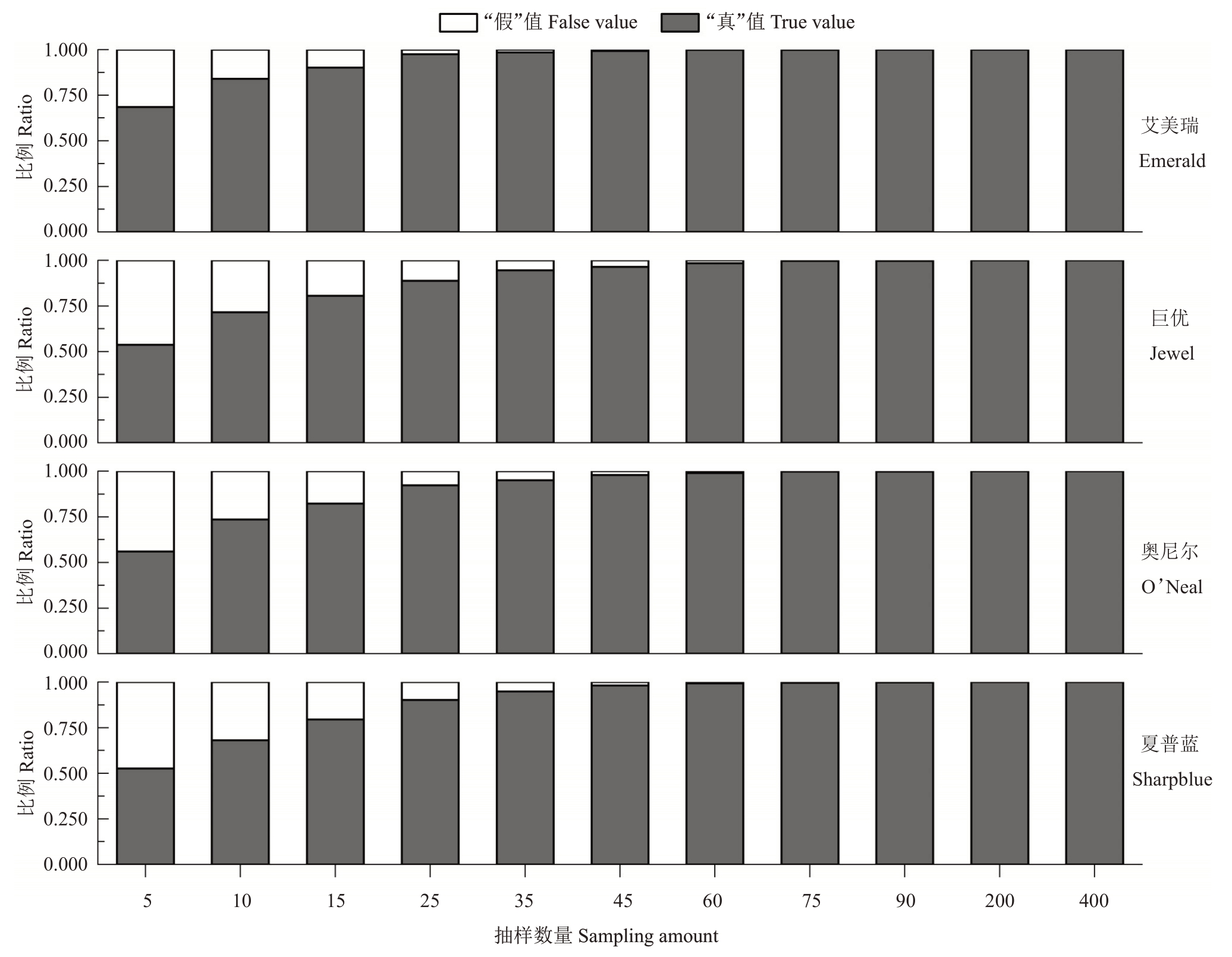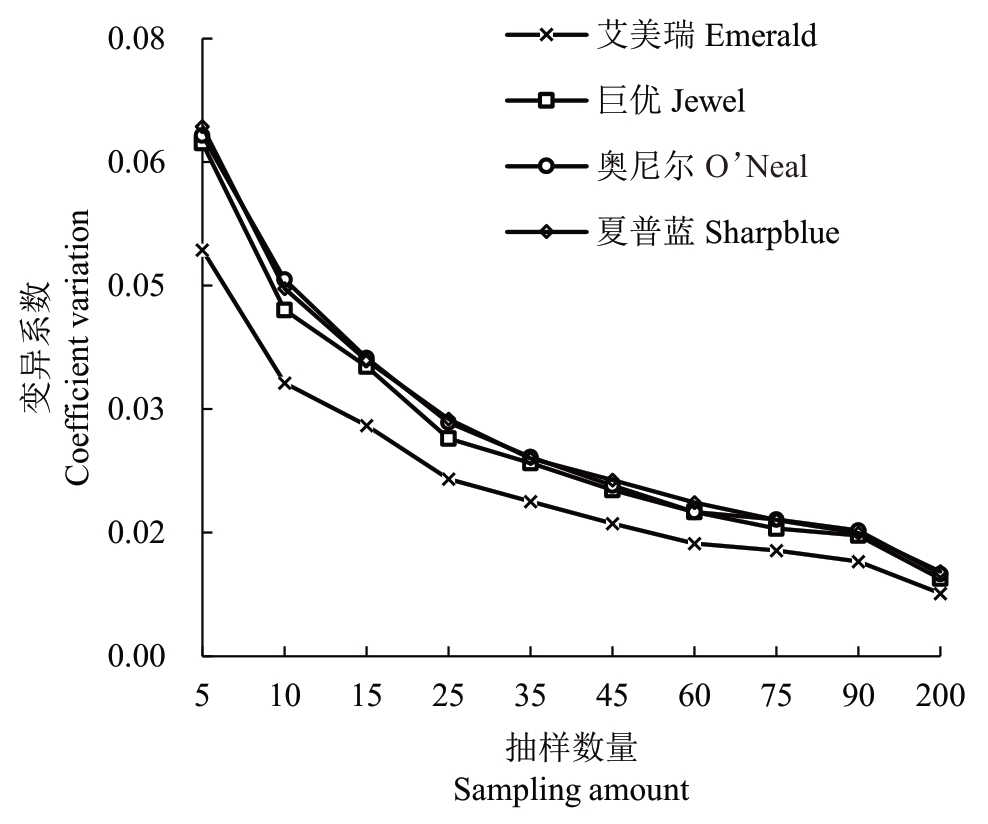果实硬度是果树非常重要的育种性状,它对果实的机械采收、内在品质、可运输性和货架期都有直接影响[1]。果实硬度与细胞壁结构、细胞膨压和角质层等的生理生化变化密切相关[2-4],一般会随着果实的发育、成熟或贮藏时间延长而逐渐下降。软化是肉质果实最典型的成熟特征之一,合适的成熟硬度可以提升果实的消费口感,而过度软化不仅会降低果实内在品质,还会增加采收、运输和贮藏过程中的果实损耗[5]。虽然在自然情况下伴随果实成熟的硬度下降不可避免,但发育期拥有更高硬度的果实在成熟时倾向于保持其硬度特征[6-7]。
果实硬度的测定在番茄属[4,8]、苹果属[9-10]、草莓属[11-12]、猕猴桃属[13-14]等植物的大果型果实方面已有较多报道。量化测定包括质构分析法、近红外光谱技术、高光谱成像技术、声特征检测法等方法[15]。质构分析法是将果实去皮后使用硬度计或质构仪对果实进行穿刺或挤压测定其硬度,是实验室常用的果实硬度量化方法;穿刺式硬度测定使用的探针存在直径和长度的差异,测定结果通常受果实类型、测定模式和参数条件等因素的影响较大[1,15],在葡萄、樱桃和蓝莓等小果型硬度测定中表现尤为明显。若照搬穿刺式方法测定小果型果实的硬度,不仅会造成测定结果不准确,也会影响同一类果实硬度测定标准的制定。
蓝莓是杜鹃花科越橘属植物,因其果实中富含花青苷且具有很高的保健价值而被广泛栽培,目前已成为全球发展最快的果树之一。全世界蓝莓总产量的70%为鲜食果[16],果实硬度对鲜食蓝莓的消费起关键作用,它直接反映了果实的新鲜程度。高硬度的蓝莓果实在咀嚼时有更大的回弹力,给消费者带来更好的脆度口感[1,17]。虽然已有基于质构仪[17-21]、硬度检测仪[22]、无损伤预测模型[23-25]等方式测定蓝莓果实硬度的报道,但前人的研究主要关注蓝莓的成熟时期和采后贮藏阶段,果实发育期硬度的报道较少;而近期的研究结果表明果实的早期发育阶段对硬度有非常重要的影响[7]。此外,无论采用哪种测量方式,取样数量和测定模式仍然是蓝莓果实硬度测定中尚未明确的问题。
笔者分析了不同取样量对蓝莓果实硬度测定的影响,基于不同形变距离和受压质量两种模式测定了蓝莓发育时期的果实硬度,建立了准确度高和重复性好的蓝莓果实硬度测定方法;在此基础上对我国主栽蓝莓品种的果实硬度进行了测定。笔者在本研究中建立和优化的方法可以为蓝莓及其他小果型果实硬度标准化测定提供参考,为硬肉型蓝莓新品种的选育打下基础。
1 材料和方法
1.1 材料
蓝莓果实采自浙江师范大学蓝莓种质资源圃。选择长江中下游地区主栽的艾美瑞(Emerald)、巨优(Jewel)、奥尼尔(O’Neal)和夏普蓝(Sharpblue)4 个蓝莓品种,每个品种选择10 株长势相近的6 年生蓝莓树,于5 月中旬采集健康的成熟果实各600 个。在室温条件下放置1 h 去除田间热,挑选大小和成熟状态相似的400 个果实用于硬度测定。参考Zifkin 等[26]对蓝莓果实发育时期的划分方式,依据果实大小和果面颜色采集奥尼尔6 个发育时期(图1)的足量(≥150 个)果实,室温条件下放置1 h 去除田间热,各时期挑选出大小和发育状态相似的100个果实用于硬度测定。

图1 奥尼尔蓝莓不同发育时期的果实
Fig.1 O’Neal fruits at different stages
1.2 蓝莓果实硬度测定采样量的确定
使用Firmtech FT7 果实硬度检测仪(UP GmbH Firmensitz,德国)测定艾美瑞、巨优、奥尼尔和夏普蓝4 个蓝莓品种成熟果实的硬度。选择形变阈值(deflection threshold)模式,设置2 mm 为硬度检测仪挤压果实产生形变的阈值,其他参数保持默认。将测定的400 个成熟果实的硬度平均值作为“真值”,对400 个测量值进行随机再抽样,设置抽样量分别为5、10、15、25、35、45、60、75、90 和200 个果实的分组。每个抽样量随机重复抽样1000 次,每次再抽样的平均值作为该样本量情况下的一个虚拟测定值,以“真值”的±5%误差作为置信区间,记录每组抽样量虚拟测定值落入置信区间的比例,统计分析后确定满足可重复性和准确度的最优采样量。
1.3 蓝莓不同发育时期果实硬度测定条件的优化
取奥尼尔蓝莓S3 到S8 共6 个发育时期的足量果实,使用Firmtech FT7 果实硬度检测仪测定不同发育时期果实的硬度,采用形变阈值和压力阈值(force threshold)两种测定模式。形变阈值模式是指预设果实受压后赤道面产生垂直形变的距离最大值,分别设置为0.5、1.0、1.5 和2.0 mm。压力阈值模式是指预设果实受压质量的最大值,分别设置为200、300 和400 g。硬度检测仪探头垂直于果实的赤道面进行测量,利用FT7 Control 软件(UP GmbH Firmensitz,德国)记录果实形变距离和受压质量并绘制回归曲线,分别分析果实硬度与形变距离(形变阈值模式)和受压质量(压力阈值模式)的相关性。
1.4 蓝莓不同品种成熟果实的硬度测定
采集36 个蓝莓品种(表1)的足量果实,利用方法1.2 和1.3 中确定的采样量和测定模式进行果实硬度测量。
表1 用于果实硬度测定的36 个蓝莓品种
Table 1 Thirty-six blueberry cultivars used for fruit firmness detection

注:#表示无信息。
Note:#.No information.
品种群Cultivar group品种Cultivar倍性[27]Ploidy品种谱系[27-28]Cultivar origin南高丛蓝莓Southern highbush blueberries 4x#4x 4x 4x 4x#4x 4x 4x Fla 61-5×Fla 62-4 Patriot×US 74(V.darrowii Florida 4B×Bluecrop)G-180(V.corymbosum)×US75(V.darrowii‘Florida 4B’×Bluecrop)Wolcott×Florida64-15 Florida67-1×Avonblue Darrow×Duke Sharpblue×MS-60 FL80-31×O’Neal 2003[29]2005[30]2005[29]1955 1959 1966 1968 1976 1989 1993 1996 2005[29]2005[31]1950 1955 1960 1974 2009 1983 2003 2001 2005[32]##果实硬度Fruit firmness/(g·mm-1)168.6 168.4 209.5 180.9 165.9 237.1 201.4 204.9 263.1 198.3 215.8 187.3 215.6 209.3 215.3 206.0 219.8 180.6 184.8 161.7 220.1 178.6 223.9 214.6 212.1 202.7 258.5 188.4 226.5 205.9 189.3 196.7 213.9 175.7 221.1 225.9 x####4 x##4发表年份[28]Release year 1975 1987 1987 1987 1987 1990 1990[20]1994 1995 1998 1998 1998 1999 1999北高丛蓝莓Northern highbush blueberry兔眼蓝莓Rabbiteye bluberry夏普蓝Sharpblue蓝脊BluerRidge库帕Cooper海岸Gulfcoast奥尼尔O’Neal密斯蒂Misty双迪D-II久比利Jubilee明星Star巨优Jewel桑普森Sampson顶级Summit艾美瑞Emerald蓝宝石Sapphire春丰Springcrop普林Springhigh普瑞Primodonna蓝光Blueray考林Collins伊丽莎白Elizabeth蓝港Bluehaven爱国者Patriot大果蓝金Big Bluegold莱格西Legacy奥扎克蓝Ozarkblue卡拉之选Cara’s choice德雷伯Draper乡铃Homebell梯芙蓝Tifblue乌达德Woodard顶峰Climax蓝沙Blueshower灿烂Brightwall红珍珠RedPearl昂丝萝Onslow沃农Vernon 4x 4x#4x 4x 4x 4x#4x#6x#6x 6x 6x 6x 6x#G144×F14-76 FL91-69×NC1528 V.darrowii 未命名优良株系Unnamed advanced-generation selection from V.darrowii#FL91-266×Southmoon O’Neal×FL87-286(Jersey×Pioneer)×(Stanley×June)Stanley×Weymouth(Katharine×Jersey)×Scammel Berkeley×19-H(lowbush×Pioneer seedling)US3×Earliblue Bluegold 自然杂交实生苗选育[20]Open pollination seedling of Bluegoldx Elizabeth×US-75 G-144×FL 4-76#Duke×G751 Myers×BlackGiant Ethel×Clara Ethel×Callaway Callaway×Ethel#Tifblue×Menditoo Ethel 自然杂交实生苗选育Open pollination seedling of Ethel Premier×Centurion(W4×Callaway)×(Brightwell×T-139)
1.5 数据处理
使用Microsoft Excel 2013 软件(Microsoft,美国)对数据进行初步处理并作图,利用SPSS 23.0 软件(IBM,美国)进行方差和相关性分析。
2 结果与分析
2.1 果实不同采样量对果实硬度测定的影响
测定了筛选后的艾美瑞、巨优、奥尼尔和夏普蓝各400 个果实的硬度,平均值分别为239.9、210.9、168.9 和262.0 g·mm-1,将该平均值作为每个品种果实硬度的“真值”。对每个品种400 个硬度测定值随机再抽样,当抽样量为5 时,果实硬度测定值上下四分位数相差最大,数据离散值多(图2);巨优、奥尼尔和夏普蓝约50%的果实硬度数据不属于“真值”95%的置信区间,艾美瑞有超过25%的数据不满足准确度要求(图3)。随着抽样量增加,测定值的离散值逐渐减小,精确度提高(图2)。当抽样量超过60 时,离散值和异常值的数量趋于饱和。在抽样量为75 时,4 个蓝莓品种果实硬度测定值在“真值”95%的置信区间的比例超过99%。虽然抽样量为90 和200 时的测定值精确度和准确度更高,但在实际测定过程中会显著增加测定的时间和成本。

图2 不同样本量下蓝莓果实硬度离散程度
Fig.2 Discrete degree of fruit firmness of blueberry with different sample sizes

图3 不同抽样量下蓝莓果实硬度属于“真值”置信区间的比例
Fig.3 The proportion of confidence intervals containing‘true’mean parameters of blueberry fruit firmness at different sample sizes
对不同抽样量的测定值进行了变异系数分析(图4),结果表明随着抽样量的增加,果实硬度测量值的变异系数快速降低。果实抽样量为5 个时,硬度测量值的变异系数最大,4 个品种均超过了0.050。当抽样量为10 到25 个时,变异系数迅速下降,当抽样量为25 个时,巨优、奥尼尔和夏普蓝测量值的变异系数约为0.030,艾美瑞变异系数最低,为0.023。当抽样量是35 到60 时,变异系数下降趋势变缓,除艾美瑞为0.020 外,其他3 个品种均接近0.025。当抽样量≥60 个时,4 个品种的变异系数均小于0.020,并且抽样量增加至90 个(含)之前,变异系数没有显著性差异。当抽样量为200 个时,艾美瑞果实硬度测定值的变异系数最低,为0.008 2,奥尼尔最高,为0.011,其他2 个品种为0.010。综合考虑品种多样性、准确度、精确度和测量成本等因素,蓝莓果实硬度测定的取样量应设置为60~75 个。

图4 不同样本量下蓝莓果实硬度测定值的变异系数
Fig.4 The coefficient of variation of fruit firmness measurement under different sample sizes
2.2 形变距离与蓝莓果实硬度的相关性
以不同形变阈值(0.5、1.0、1.5 和2.0 mm)对奥尼尔不同发育时期果实(图1)的硬度进行了测定,对形变距离和果实硬度进行相关性分析(图5)。结果表明,当形变阈值为0.5、1.0 和1.5 mm 时,S3 时期的果实硬度与形变距离的相关系数无显著差异,形变阈值为2.0 mm 时的相关系数显著低于其他3种距离。但阈值为0.5 和2.0 mm 时,其硬度显著低于形变阈值为1.0 和1.5 mm 模式下的硬度。S4 时期果实硬度的测定值和相关系数都随着形变阈值的增加呈现下降趋势,硬度测定值在4 种形变距离下存在显著差异。随着形变阈值的增加,S5 到S8时期果实硬度测量值及其与形变距离之间的相关系数呈现上升趋势,在形变阈值≥1.0 mm 时趋于平缓。当形变阈值为0.5 mm 时,S5 到S8 时期的硬度测量值与形变距离之间的相关系数显著低于其他形变距离,当形变阈值≥1.0 mm 时,S5、S7 和S8 时期果实硬度和形变距离之间的相关系数无显著差异。果实硬度测量值变化较大,形变阈值为0.5 和1.0 mm 时的硬度测量值显著低于1.5 和2.0 mm时,在1.5 和2.0 mm 形变阈值时,S5 到S8 时期果实硬度测量值无显著差异。综上,形变阈值1.0 mm更适合用于测定硬度较高的S3 和S4 时期蓝莓果实,1.5 和2.0 mm 更适宜测定硬度逐渐下降的S5到S8 时期的蓝莓果实。

图5 不同固定形变量测量模式下果实硬度及相关系数
Fig.5 Fruit firmness and correlation coefficient under different measurement modes of fixed shape variables
2.3 果实受压质量与蓝莓果实硬度的相关性
以不同压力阈值模式(200、300 和400 g)对奥尼尔不同发育时期果实(图1)的硬度进行了测定,对果实硬度和过程压力值进行相关性分析(图6)。随着压力阈值的增加,果实硬度测定值及其与压力值的相关系数呈上升趋势。压力阈值为200 g 时的果实硬度测定值与过程压力值的相关系数均显著低于300 和400 g 时的相关系数。但只有在S3、S4和S6 时期,压力阈值300 g 和400 g 模式下果实硬度测定值与过程压力值之间的相关系数存在显著性差异。3 种压力阈值模式下测定的S3 和S5 时期果实硬度均存在显著性差异,400 g 模式的测定值显著大于200 和300 g 模式下的测定值。在S3 到S5 时期,随着压力阈值的增加,硬度测定值显著提高,过程压力值和果实硬度之间的相关系数增大。在S6到S8 时期,压力阈值越高,过程压力值和果实硬度之间的相关系数越高,且阈值超过300 g 后,硬度测定值在3 个时期中没有显著性差异,硬度测定值及其与过程压力值的相关系数趋于平缓。综上,400 g压力阈值模式适于测定S3 到S8 时期的果实硬度。

图6 压力阈值模式下蓝莓不同发育时期的果实硬度及其与压力值的相关系数
Fig.6 Fruit firmness and correlation coefficient between fruit firmness and force-on-fruit for different stages of blueberry under force threshold modes
2.4 蓝莓不同品种的果实硬度及硬度育种趋势
形变阈值2.0 mm(209.5 ± 2.0 g·mm-1)和压力阈值400 g(198.7±2.5 g·mm-1)模式下的奥尼尔S8时期果实硬度相似,但形变阈值模式下的相关系数(0.998 8)略高于压力阈值模式(0.998 4),综合考虑硬度测定值及硬度与形变距离、压力值之间的相关系数,使用形变阈值2.0 mm 模式测定了17 个南高丛蓝莓品种、9 个北高丛蓝莓品种和10 个兔眼蓝莓品种的成熟果实硬度(表1),果实硬度变化范围是161.7~263.1 g·mm-1。南高丛蓝莓品种平均硬度为205.0 g·mm-1,其中明星硬度最大,为263.1 g·mm-1,奥尼尔果实硬度最小,为165.9 g·mm-1。北高丛蓝莓果实硬度为161.7~258.5 g·mm-1,平均硬度为203.9 g·mm-1,硬度最大和最小的蓝莓品种分别是德雷伯和伊利沙白。兔眼蓝莓品种平均硬度为202.6 g·mm-1,其中梯芙蓝硬度最大,为226.5 g·mm-1,红珍珠品种果实硬度最小,为175.7 g·mm-(1图7)。综合分析果实硬度与蓝莓品种育成时间之间的趋势特征,结果发现果实硬度随品种选育时间呈现逐渐增大的趋势(图7-A)。南高丛蓝莓和北高丛蓝莓近期育成品种的果实硬度一般大于年代久远的品种,这种趋势在南高丛蓝莓品种群中表现得更为突出(图7-B)。

图7 蓝莓不同品种成熟果实的硬度及其育种趋势
Fig.7 Fruit firmness at maturity of different blueberry cultivars and firmness breeding trend
3 讨 论
蓝莓已经成为仅次于草莓的全球第二大浆果类型[26,33-34],近些年栽培面积和产量不断增加,但鲜食果价格仍居高不下[35],主要原因在于人工采摘劳动成本高,鲜果生产过程损耗大[36],而机械化采收和果实硬度增大是有效的解决途径[1]。果实硬度对蓝莓鲜食、储运和货架期都有重要影响[34],准确的果实硬度测定是果实品质评价和市场质量分级的前提[22,37]。笔者利用Firmtech FT7 果实硬度检测仪探讨了蓝莓发育期果实硬度准确测定所需的样本数量和检测模式,发现果实取样数量为60~75 个时能获得准确度高、可重复性好的果实硬度测量值。前人在蓝莓硬度相关研究中采用的果实取样范围为5~100 个[1],多数研究的取样量为20~30 个[3,18,20],也有一些研究[5,17,22,38]没有明确指出用于硬度测定的果实数量。尽管Cappai 等[1]指出用于硬度测量的蓝莓果实数量为25 个时,异常值可以降至10%,但为了获得更加可靠的果实硬度数据,建议在条件允许的情况下测定≥60 个果实作为品种的果实硬度特征值。
早期大多使用手持式硬度计、通用测试机(instron testing machine)测定苹果、梨和桃等果实的硬度,但由于蓝莓果实直径远小于上述果实,无法直接使用大果型果实的硬度测定方法[1]。目前在蓝莓果实硬度测定中最常用的仪器是Firmtech 果实硬度检测仪,虽然质构仪和无损检测等仪器或方法也多有使用,但质构仪的探头大小和形状多种多样,使得硬度的测定过程难以标准化,在大规模测定中费时费力[15]。蓝莓果实在生长发育直至成熟的过程中内含物变化非常大,果实质地处于动态变化的过程中,而果实硬度的测定一般是基于挤压或穿刺等单一模式得到的反馈值,对发育期果实采用单一模式进行硬度测定会影响准确度。笔者对硬度测定的两种常用模式进行了比较,发现400 g 压力阈值模式比形变阈值更适合测定坐果期(S3)和膨大期(S4)的蓝莓果实。对于白绿期(S5)之后的蓝莓果实硬度测定,2.0 mm 的形变阈值模式优于压力阈值模式。
蓝莓的驯化栽培和品种选育开始于20 世纪初的美国,近30 年选育的蓝莓品种比最初育成的蓝莓品种有更高的果实硬度[1]。蓝莓品种的遗传背景涉及常绿蓝莓(V.darrowii)、高丛蓝莓、矮丛蓝莓和兔眼蓝莓等多个种,前人整理分析了多个蓝莓品种的果实硬度,发现遗传背景中以常绿蓝莓和兔眼蓝莓为主的品种果实硬度更大,而以矮丛蓝莓为亲本种选育的品种果实更软[1],这与笔者在本研究中得到的结果基本一致。果实硬度是蓝莓育种长期备受关注的关键性状之一,在栽培品种果实硬度改良过程中,充分利用硬度大的越橘属近缘野生种,将其与栽培品种蓝莓杂交[39-40],选育更适合机械采收和耐贮藏的新品种将是未来蓝莓育种的主要趋势。
4 结 论
果实硬度在蓝莓果实不同发育时期变化较大。当使用Firmtech FT7 果实硬度计测定蓝莓果实硬度时,果实数量≥60 个测定的硬度值可以作为品种的特征值,最优测定模式为400 g 压力阈值与2.0 mm形变阈值混合模式,或1.0 和2.0 mm 结合的形变阈值模式。高硬度的蓝莓品种如南高丛蓝莓明星和密斯蒂、北高丛蓝莓德雷伯、兔眼蓝莓沃农和梯芙蓝可以作为硬肉型蓝莓品种选育的备选亲本。
[1]CAPPAI F,BENEVENUTO J,FERRÃO L F V,MUNOZ P.Molecular and genetic bases of fruit firmness variation in blueberry:A review[J].Agronomy,2018,8(9):174.
[2]FORLANI S,MASIERO S,MIZZOTTI C. Fruit ripening:the role of hormones,cell wall modifications,and their relationship with pathogens[J]. Journal of Experimental Botany,2019,70(11):2993-3006.
[3]CHEA S,YU D J,PARK J,OH H D,CHUNG S W,LEE H J.Fruit softening correlates with enzymatic and compositional changes in fruit cell wall during ripening in‘Bluecrop’highbush blueberries[J].Scientia Horticulturae,2019,245:163-170.
[4]ROMERO P,ROSE J K C.A relationship between tomato fruit softening,cuticle properties and water availability[J]. Food Chemistry,2019,295:300-310.
[5]LIU B H,WANG K F,SHU X G,LIANG J,FAN X L,SUN L.Changes in fruit firmness,quality traits and cell wall constituents of two highbush blueberries (Vaccinium corymbosum L.)during postharvest cold storage[J]. Scientia Horticulturae,2019,246:557-562.
[6]MONTECCHIARINI M L,SILVA-SANZANA C,VALDERRAMO L,……,TRIPODI K E J. Biochemical differences in the skin of two blueberries (Vaccinium corymbosum) varieties with contrasting firmness:Implication of ions,metabolites and cell wall related proteins in two developmental stages[J].Plant Physiology and Biochemistry,2021,162:483-495.
[7]HUANG B W,HU G J,WANG K K,FRASSE P,MAZA E,DJARI A,DENG W,PIRRELLO J,BURLAT V,PONS C,GRANELL A,LI Z G,van der REST B,BOUZAYEN M. Interaction of two MADS-box genes leads to growth phenotype divergence of all-flesh type of tomatoes[J]. Nature Communications,2021,12(1):6892.
[8]ULUISIK S,CHAPMAN N H,SMITH R,……,SEYMOUR G B. Genetic improvement of tomato by targeted control of fruit softening[J].Nature Biotechnology,2016,34(9):950-952.
[9]ATKINSON R G,SUTHERLAND P W,JOHNSTON S L,GUNASEELAN K,HALLETT I C,MITRA D,BRUMMELL D A,SCHRÖDER R,JOHNSTON J W,SCHAFFER R J. Down-regulation of POLYGALACTURONASE1 alters firmness,tensile strength and water loss in apple (Malus × domestica) fruit[J].BMC Plant Biology,2012,12(1):129.
[10]TONG C,MCKAY S J,LUBY J J,BEAUDRY R,CONTRERAS C,NOCK J F,WATKINS C B. Using mixed-effects models to estimate the effect of harvest date and its interactions with post-harvest storage regime on apple fruit firmness[J].The Journal ofHorticulturalScienceandBiotechnology,2013,88(1):29-36.
[11]MORA F,ZÚÑIGA P E,FIGUEROA C R. Genetic variation and trait correlations for fruit weight,firmness and color parameters in wild accessions of Fragaria chiloensis[J]. Agronomy,2019,9(9):506.
[12]ZHANG WW,ZHAO S Q,ZHANG LC,XINGY,JIAWS.Changes in the cell wall during fruit development and ripening in Fragariavesca[J].Plant Physiology and Biochemistry,2020,154:54-65.
[13]ZHANG A D,WANG W Q,TONG Y,LI M J,GRIERSON D,FERGUSON I,CHEN K S,YIN X R. Transcriptome analysis identifies a zinc finger protein regulating starch degradation in kiwifruit[J].Plant Physiology,2018,178(2):850-863.
[14]TERASAKI S,SAKURAI N,KUROKI S,YAMAMOTO R,NEVINS D J. A new descriptive method for fruit firmness changes with various softening patterns of kiwifruit[J]. Postharvest Biology and Technology,2013,86:85-90.
[15]陈桂香,杨天天,孙蕾,朱子成,刘宏宇,王学征.园艺作物果实硬度测量方法研究进展[J].分子植物育种,2021:1-9.[2022-09-23].http://kns.cnki.net/kcms/detail/46.1068.S.20210722.1422.016.html.CHEN Guixiang,YANG Tiantian,SUN Lei,ZHU Zicheng,LIU Hongyu,WANG Xuezheng . Research progress on measurement of fruit hardness in horticulture crops[J]. Molecular Plant Breeding,2021:1-9 [2022-09-23]. http://kns.cnki.net/kcms/detail/46.1068.S.20210722.1422.016.html
[16]李亚东,盖禹含,王芳,刘成,刘有春,陈丽.2021 年全球蓝莓产业数据报告[J].吉林农业大学学报,2022,44(1):1-12.LI Yadong,GAI Yuhan,WANG Fang,LIU Cheng,LIU Youchun,CHEN Li. Global blueberry industry report 2021[J]. Journal of Jilin Agricultural University,2022,44(1):1-12.
[17]纪淑娟,马超,周倩,程顺昌,魏宝东.蓝莓果实贮藏期间软化及相关指标的变化[J].食品科学,2013,34(12):341-345.JI Shujuan,MA Chao,ZHOU Qian,CHENG Shunchang,WEI Baodong. Softening and softening indices change of blueberry during storage[J].Food Science,2013,34(12):341-345.
[18]李洋,张茜,陈业莉,刘美爽.贮运过程中振动损伤对蓝莓品质的影响[J].林业科学,2020,56(9):40-50.LI Yang,ZHANG Qian,CHEN Yeli,LIU Meishuang. Effect of vibration damage on blueberry quality during storage and transportation[J].Scientia Silvae Sinicae,2020,56(9):40-50.
[19]刘丙花,孙锐,王开芳,舒秀阁,孙蕾.不同蓝莓品种果实品质比较与综合评价[J].食品科学,2019,40(1):70-76.LIU Binghua,SUN Rui,WANG Kaifang,SHU Xiuge,SUN Lei. Comparison and comprehensive evaluation of fruit quality of different blueberry (Vaccinium spp.) varieties[J]. Food Science,2019,40(1):70-76.
[20]刘丙花,王开芳,王小芳,梁静,白瑞亮,谢小锋,孙蕾.基于主成分分析的蓝莓果实质地品质评价[J]. 核农学报,2019,33(5):927-935.LIU Binghua,WANG Kaifang,WANG Xiaofang,LIANG Jing,BAI Ruiliang,XIE Xiaofeng,SUN Lei. Evaluation of fruit texture quality of blueberry based on principal component analysis[J]. Journal of Nuclear Agricultural Sciences,2019,33(5):927-935.
[21]许时星,郜海燕,陈杭君,韩强.振动胁迫对蓝莓果实品质和抗氧化酶活性的影响[J].林业科学,2017,53(9):26-34.XU Shixing,GAO Haiyan,CHEN Hangjun,HAN Qiang.Effect of vibration on shelf quality and antioxidant enzyme activity of blueberries[J].Scientia Silvae Sinicae,2017,53(9):26-34.
[22]张佳,聂继云,张惠,李静,李也.越橘品质指标评价[J].中国农业科学,2019,52(12):2128-2139.ZHANG Jia,NIE Jiyun,ZHANG Hui,LI Jing,LI Ye. Evaluation indexes for blueberry quality[J]. Scientia Agricultura Sinica,2019,52(12):2128-2139.
[23]李瑞,傅隆生.基于高光谱图像的蓝莓糖度和硬度无损测量[J].农业工程学报,2017,33(S1):362-366.LI Rui,FU Longsheng. Nondestructive measurement of firmness and sugar content of blueberries based on hyperspectral imaging[J].Transactions of the Chinese Society of Agricultural Engineering,2017,33(S1):362-366.
[24]HU M H,DONG Q L,LIU B L,OPARA U L.Prediction of mechanical properties of blueberry using hyperspectral interactance imaging[J]. Postharvest Biology and Technology,2016,115:122-131.
[25]薛璐,刘小路,鲁晓翔,张鹏,陈绍慧,李江阔.近红外漫反射无损检测蓝莓硬度的研究[J]. 浙江农业学报,2015,27(9):1646-1651.XUE Lu,LIU Xiaolu,LU Xiaoxiang,ZHANG Peng,CHEN Shaohui,LI Jiangkuo. Non-destructive detection of blueberry hardness based on near-infrared diffused spectroscope[J]. Acta Agriculturae Zhejiangensis,2015,27(9):1646-1651.
[26]ZIFKIN M,JIN A,OZGA J A,ZAHARIA L I,SCHERNTHANER J P,GESELL A,ABRAMS S R,KENNEDY J A.,CONSTABEL C P. Gene expression and metabolite profiling of developing highbush blueberry fruit indicates transcriptional regulation of flavonoid metabolism and activation of abscisic acid metabolism[J].Plant Physiology,2012,158(1):200-224.
[27]SAKHANOKHO H F,RINEHART T A,STRINGER S J,ISLAM-FARIDI N,POUNDERS C. Variation in nuclear DNA content and chromosome numbers in blueberry[J]. Scientia Horticulturae,2018,233:108-113.
[28]渡辺順司.ブルーベリー品種改良の系譜.ブルーベリー大図鑑.品種読本[M].日本:株式会社マルモ出版,2006.Jyunji Watanabe. Blueberry pictural book[M]. Japan:Marumo Publishing Co.,Ltd.,2006.
[29]JORGE R,JAMES H. Blueberry taxonomy and breeding. Blueberries 2nd edition[M].United States:CABI,2018.
[30]PAUL L. Blueberry plant called‘Springhigh’:United States,USPP16,404 P3[P].2006-04-04.
[31]JAMES H. Blueberry plant denominated‘Draper’:United States,USPP15,103 P2[P].2004-08-24.
[32]NESMITH S D,DRAPER A D. Rabbiteye blueberry plant named‘Vernon’United States:USPP18,291 P3[P].2007-12-11
[33]BRAZELTON C,KAYLA Y,BAUER N. Global Blueberry Statistics and Intelligence Report[J]. International Blueberry Organization,2017.
[34]CHEN H J,CAO SF,FANG X J,MU H L,YANG H L,WANG X,XU Q Q,GAO H Y. Changes in fruit firmness,cell wall composition and cell wall degrading enzymes in postharvest blueberries during storage[J]. Scientia Horticulturae,2015,188:44-48.
[35]USDA. Economic Research Service Fruit and Vegetable Prices.Available online at:https://www.ers.usda.gov/data- products/fruit-and-vegetable-prices.aspx(accessed March 4,2022).
[36]GALLARDO R K,STAFNE E T,DEVETTER L W,ZHANG Q,LI C,TAKEDA F,WILLIAMSON J,YANG W Q,CLINE W O,BEAUDRY R,ALLEN R. Blueberry producers’attitudes toward harvest mechanization for fresh market[J].HortTechnology,2018,28(1):10-16.
[37]CHEN L,OPARA U L. Approaches to analysis and modeling texture in fresh and processed foods:A review[J]. Journal of Food Engineering,2013,119(3):497-507.
[38]WANG S Y,ZHOU Q,ZHOU X,ZHANG F,JI S J.Ethylene plays an important role in the softening and sucrose metabolism of blueberries postharvest[J].Food Chemistry,2020,310(C):125965.
[39]徐国辉,雷蕾,安琪,罗霖锜,王贺新.美国越橘属资源在蓝莓育种中的利用及发展趋势分析[J]. 果树学报,2021,38(7):1173-1189.XU Guohui,LEI Lei,AN Qi,LUO Linqi,WANG Hexin. Utilization and development trend analysis of Vaccinium of America in blueberry breeding[J]. Journal of Fruit Science,2021,38(7):1173-1189.
[40]甄成,李淑娟,张玉双,严善春,孙小环,许艳玲,张雅奎. 蓝莓种间杂交及杂交种子的无菌萌发[J].东北林业大学学报,2016,44(1):52-55.ZHEN Cheng,LI Shujuan,ZHANG Yushuang,YAN Shanchun,SUN Xiaohuan,XU Yanling,ZHANG Yakui.Intervarietal crosses and hybrid seedlings aseptic germination of blueberry[J].Journal of Northeast Forestry University,2016,44(1):52-55.